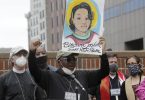
For much of U.S. history, elections were determined not by who turned out to vote but by who was allowed to do so at all. Turnout in presidential elections sometimes exceeded 80 percent in the mid-19th century, but women, men between 18 and 21, and most African- and Native-Americans—the overwhelming majority of adults—were barred from participating. Black men gained the right to vote in 1870 but were effectively driven from the polls across the South in a campaign of terror led by the Ku Klux Klan, the celebration of which launched the first Hollywood blockbuster, The Birth of a Nation. Women joined the rolls in 1920 and increasing numbers of black and Hispanic people after the passage of the 1965 Voting Rights Act, which banned racial discrimination in voting.
But something surprising happened after the pool of voters expanded. The enactment of the 26th Amendment, which extended the franchise to young people in 1971, was soon followed by a fall in turnout. The proportion of the electorate to cast ballots fell by about 10 percentage points between 1968 and 1998 to just over 51 percent in presidential contests and under 40 percent in the midterms. It’s risen a bit since, but more than 40 percent of the U.S. electorate still sits out the process, roughly twice the proportion of Sweden, Denmark, South Korea or New Zealand, none of which has mandatory voting. One of the biggest questions in American politics has become why so many people have checked out.
Over the years, scholars have found nonvoters fall into camps with very different political inclinations and reasons for not participating.
More in Common, a nonpartisan organization that aims to develop new strategies to reduce polarization in Western democracies, partnered with YouGov on a survey of 8,000 Americans to understand their underlying values and core beliefs, revealing seven “Hidden Tribes” they say provide a much more accurate and revealing framework for understanding the country than slicing and dicing the electorate using conventional markers like age, gender, race and partisan affiliations.
Like other scholars, their research identified a substantial cohort of would-be Democratic voters who rarely participate in the political process. These “passive liberals” are weakly engaged but progressive on most issues when they are, isolated from “the system” and fatalistic about how it will affect their lives, and far more likely to be African American and to feel the world is becoming more dangerous. They constitute 15 percent of the voting age population.
“They’re younger, more urban, more female, more black and Hispanic on average and have a clear orientation toward the Democratic Party,” says Stephen Hawkins, More in Common’s director of research. “But they feel disaffected and cynical toward the system so they are less inclined to vote as a whole.”
This group closely mirrors one of two camps that Ibram X. Kendi, founding director of American University’s Antiracist Research and Policy Center, has called the “other swing voters,” the ones who chose not between voting for the Democrats or the Republicans but rather between Democrat and not voting at all. “There are two kinds of nonvoters, the person who is a ‘nonvoter’ as an identity and the person who often chooses not to vote after they did vote in a specific election but consider themselves voters and who might think voting is absolutely crucial,” he notes.
These “passive liberals” stand in stark contrast to a larger mass of nonvoters who are far more profoundly disengaged from and disinterested in politics. More in Common calls this tribe the “Politically Disengaged,” a group comprising 26 percent of Americans, who are almost invisible in local politics and community life. As a group, they’re much poorer and less educated than the average American and much more likely to say that “being white” is important to being an American—20 percent, rather than 11 percent—to say people of other religions are morally inferior and to say that a “strong leader willing to break the rules” is needed to fix America,57 percent to 45. They are much more eclectic of a group than More in Common’s other “tribes,” like Progressive Activists and Devoted Conservatives.
Source: politico.com
See more here: news365.stream





